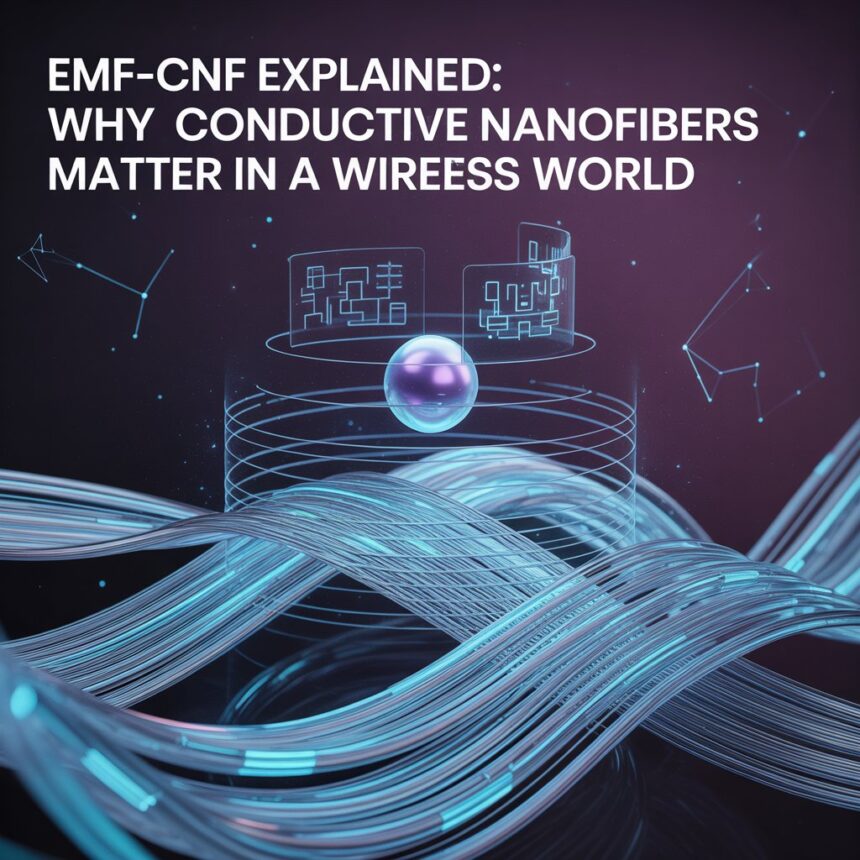As our world becomes increasingly wireless—with smartphones, IoT devices, 5G networks, and smart homes dominating daily life—concerns about electromagnetic fields (EMFs) are growing. These invisible waves are all around us, emitted by everything from Wi-Fi routers to power lines.
To manage exposure and interference from these EMFs, scientists and engineers have turned to a promising new material: EMF-CNF, or Electromagnetic Field – Conductive Nanofibers. But what exactly is EMF-CNF, and why does it matter?
Let’s break it down.
What is EMF-CNF?
EMF-CNF refers to the use of conductive nanofibers engineered specifically to interact with and shield against electromagnetic fields (EMFs). These nanofibers are incredibly thin—often 1,000 times thinner than a human hair—but they have powerful conductive and shielding properties.
They are typically made from materials such as:
-
Carbon nanotubes
-
Graphene
-
Conductive polymers
-
Metal-coated fibers (e.g., silver or copper)
When these fibers are woven or layered into fabrics, films, or composites, they can effectively block, absorb, or redirect EMF radiation.
Why Conductive Nanofibers Matter in a Wireless World
1. EMF Shielding for Electronics
In an increasingly wireless environment, electronic devices are more susceptible to electromagnetic interference (EMI). EMF-CNF materials provide a lightweight, flexible solution for protecting sensitive circuits without adding bulk—crucial for smartphones, laptops, and aerospace electronics.
2. Smart Textiles and Wearables
Wearable technology is booming, from fitness trackers to smart clothing. EMF-CNF-infused fabrics allow wearables to be not only functional but also shielded from or capable of detecting EMFs, improving performance and user safety.
3. Biomedical Applications
EMF-CNF materials are being explored in healthcare devices, such as biosensors and therapeutic wearables, which must operate accurately near other electronic equipment. Their biocompatibility and conductivity make them ideal for such applications.
4. Improving Data Transmission
Some research suggests that conductive nanofibers can also help manage EMF emissions in high-speed data environments, reducing “noise” and improving clarity in signal transmission—important for 5G and beyond.
5. Sustainable and Lightweight Alternatives
Unlike heavy metal-based shielding, CNF materials are often lighter, more flexible, and can even be biodegradable, depending on the source materials. This opens the door for eco-friendly design in tech products.
Challenges in EMF-CNF Development
Despite the promise, there are challenges:
-
Scalability: Producing nanofibers at industrial scale remains costly and complex.
-
Durability: Some CNF materials degrade over time or under harsh conditions.
-
Standardization: EMF shielding performance varies widely without global standards.
Ongoing research aims to overcome these hurdles.
How EMF-CNF Works: The Science Behind the Shield
To understand why EMF-CNF is so effective, it’s useful to look at the science behind it.
Conductive nanofibers interact with electromagnetic waves in several ways:
-
Reflection: When EMF radiation hits the conductive nanofiber surface, a portion of the wave is reflected away—similar to how a mirror reflects light.
-
Absorption: Some of the energy is absorbed and dissipated as heat within the fibers.
-
Scattering: At the nanoscale, EM waves are scattered, reducing their strength.
-
Attenuation: Overall, the EMF is weakened (attenuated) before it can pass through to sensitive electronics or human tissue.
This combination of mechanisms makes CNFs ideal for use in multi-layered shielding systems, where high performance is required in minimal space.
Materials Commonly Used in EMF-CNF
The effectiveness of EMF-CNF depends on the type of material used. Commonly used conductive nanofiber materials include:
-
Carbon Nanotubes (CNTs)
Excellent electrical conductivity and thermal resistance; widely used in high-performance composites. -
Graphene Nanofibers
Ultra-thin, flexible, and highly conductive—ideal for wearable electronics and sensors. -
Metal-Coated Polymer Nanofibers
These combine flexibility with the high conductivity of metals like silver, nickel, or copper. -
Conductive Polymers (e.g., polyaniline, polypyrrole)
These materials offer tunable conductivity and are often used when biocompatibility or flexibility is critical. -
Cellulose-Based CNFs (Eco-Friendly Options)
Derived from natural sources and often functionalized with conductive particles for sustainable, lightweight shielding.
Each material offers different strengths in terms of flexibility, conductivity, weight, cost, and scalability, which makes them suitable for different use cases.
Emerging Research Trends in EMF-CNF
Research into EMF-CNF is evolving rapidly. Some of the most exciting trends include:
1. Self-Healing CNF Materials
Nanofiber composites that can automatically repair micro-cracks or tears, extending their usability in wearable or aerospace tech.
2. 3D-Printed CNF Structures
Additive manufacturing (3D printing) of CNFs allows for custom shielding solutions that can be integrated directly into devices.
3. Multi-Functional CNFs
Nanofibers that can simultaneously shield EMFs, sense temperature or pressure, and even harvest energy (e.g., from movement or heat).
4. Eco-Friendly CNFs
There’s a growing focus on reducing environmental impact through green synthesis, biodegradable fibers, and recyclable composites.
Practical Use Cases for EMF-CNF
✅ 1. Medical Devices
-
Shielding pacemakers, ECG monitors, and wearable biosensors from interference in hospital environments.
✅ 2. Military and Aerospace
-
Lightweight, high-performance shielding materials for aircraft, drones, and communication equipment.
✅ 3. Consumer Electronics
-
Used in phones, tablets, and laptops to reduce EMI (electromagnetic interference) while improving signal clarity.
✅ 4. Smart Clothing
-
Integrated into athletic or medical wearables to monitor biometric data while shielding the user from EM radiation.
✅ 5. Automotive Industry
-
Ensures electronic components in electric and autonomous vehicles remain interference-free.
Extended Conclusion: A Smart Future with EMF-CNF
As we continue to integrate wireless technologies into every aspect of our lives—from smart homes to autonomous vehicles and remote healthcare—our exposure to electromagnetic radiation also increases. While most EMFs are within safe limits, the need to control exposure, prevent interference, and ensure device reliability has never been greater.
EMF-CNF materials are a breakthrough solution. Their nanoscale design, lightweight structure, and powerful shielding capabilities make them an ideal match for the compact, high-performance, and flexible devices of tomorrow.
Moreover, their versatility in sensing, shielding, and even healing opens up new frontiers for innovation across industries.







